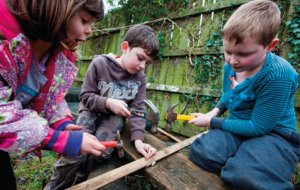 Today marks a new phase in the move to a more balanced, thoughtful approach to risk management risk in children’s play and learning, with the launch of a short, easy-to-use assessment tool.
Today marks a new phase in the move to a more balanced, thoughtful approach to risk management risk in children’s play and learning, with the launch of a short, easy-to-use assessment tool.
The risk-benefit assessment (RBA) form for the first time gives councils, schools and others an authoritative, practical document to help them weigh up risks and benefits. It is published by Play Scotland in partnership with Play England, Play Wales and PlayBoard Northern Ireland, and was commissioned and developed by the Play Safety Forum.
Announcing the launch Robin Sutcliffe, Chair of the Play Safety Forum said:
‘Children need and choose exciting places to play, which inevitably means managing situations that are inherently risky. The RBA form will help providers assess how this can be reconciled with a natural desire for children’s safety.’
Judith Hackitt, Chair of the Health and Safety Executive (HSE) said:
‘Play – and particularly play outdoors – teaches young people how to deal with risk. Without this awareness and learning they are ill equipped to deal with adult life. Outdoor play and learning is an important part of our children’s education.
‘HSE endorses the proportionate advice in the RBA Form. We should all make sure that needless health and safety excuses do not get in the way of activities. Of course take sensible and reasonable precautions, but let young people play.’
There are in fact two versions of the tool. The first is a blank form (5 MB, Word 2007 format) which is ready for use, and also easily adapted and customised. The second version is a hypothetical worked example based on a tree swing in a municipal park, which illustrates the approach (7 MB, pdf format).
The thinking and context behind the RBA form is set out in its longer predecessor Managing Risk in Play Provision: Implementation Guide (published in a revised edition in 2013). The HSE’s own helpful High Level Statement on risk and play – which everyone concerned to promote a more balanced approach should be familiar with – is here. This post of mine gives some more background on it, while this post shows just why it is so valuable.
I should confess a personal interest: I was one of the co-authors of the form, along with my longstanding collaborators Prof David Ball and Bernard Speigal of PLAYLINK. The form has benefited from comments from members of the Play Safety Forum, and also feedback on early drafts from a number of play providers, including an after-school club, a play equipment manufacturer and two local authorities.
David, Bernard and I – along with many others – share a worry about the spread of what the HSE has called ‘useless paperwork mountains’. So it is reasonable to ask if what the world really needs is yet another form. But the demand for accountability and paper trails is not going to go away any time soon. What is more, there is a place for well-designed forms that help people make the sometimes difficult decisions that are involved in managing risk in children’s play and learning. If forms are our tools, we should make sure that we are using the right tools for the job.
I know that some providers and designers have been using RBA for some years now, while others have yet to make the shift. I plan to share some case studies here in upcoming posts. But in the meantime, I would love to hear your experiences if you have implemented risk-benefit assessment in your setting or service – or if you have not, what you think are the biggest barriers to change.




















